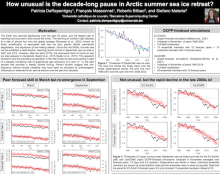How unusual is the decade-long pause in Arctic summer sea ice retreat?
Patricia
DeRepentigny
UCLouvain
Poster
The Earth has warmed significantly over the past 40 years, and the fastest rate of warming has occurred in and around the Arctic. The warming of northern high latitudes at a rate of almost four time the global average (Rantanen et al., 2022), known as Arctic amplification, is associated with sea ice loss, glacier retreat, permafrost degradation, and expansion of the melting season. Since the mid-2000s, summer sea ice has exhibited a rapid decline, reaching record minima in September sea ice area in 2007 and 2012. However, after the early 2010s, the downward trend of minimum sea ice area appears to decelerate (Swart et al., 2015; Baxter et al., 2019). This apparent slowdown and the preceding acceleration in the rate of sea ice loss are puzzling in light of a steadily increasing rate of greenhouse gas emissions of 2 ppm yr−1 in the past decade that provides a steady climate forcing. Recent studies suggest that low-frequency internal climate variability may have been as important as anthropogenic influences on observed Arctic sea ice decline over the past four decades. Here, we investigate how unusual this decade-long pause in Arctic summer sea ice decline is within the context of internal climate variability. To do so, we use simulations from the Decadal Climate Prediction Project (DCPP) contribution to CMIP6 to determine if initializing decadal prediction systems from estimates of the observed climate state substantially improves their performance in predicting this slowdown in Arctic sea ice loss over the past decade. As the DCPP does not specify the data or the methods to be used to initialize forecasts or how to generate ensembles of initial conditions, we will also assess how different formulations affect the skill of the forecasts by analyzing differences between models. This work provides an opportunity to attribute this deceleration in Arctic sea ice decline to the interannual internal variability or the radiative external forcings, something that observation analysis alone cannot achieve.

Poster file
